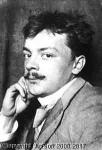Koloman Moser
Koloman Moser
Style: Art Nouveau; Symbolism; Naive Art / Primitivism; Realism;
Place: Vienna
Born: 1868
Death: 1918
Biography:
, a renowned Austrian artist, left an indelible mark on the world of art, particularly in the realm of graphic art and the Vienna Secession movement. Born on March 30, 1868, in Vienna, Austria, Moser's work encapsulates the essence of early 20th-century aesthetics.
Early Life and Education
Moser's artistic journey began with his studies at the Wiener Akademie and the Kunstgewerbeschule, where he later taught from 1899. This academic foundation laid the groundwork for his versatile career, which would span various mediums.
Artistic Contributions
- Graphic Art: Moser's influence on graphic art is profound, with designs ranging from postage stamps to magazine vignettes.
- Fashion and Applied Arts: His work in fashion, stained glass windows, porcelains, ceramics, blown glass, tableware, silver, jewelry, and furniture is a testament to his versatility.
- Architecture: Moser's designs in architecture, including the notable Apse mosaic and glass windows for the Kirche am Steinhof in Vienna (1904), showcase his architectural prowess.
Notable Collaborations and Founding of Wiener Werkstätte
In 1903, Moser co-founded the Wiener Werkstätte with Josef Hoffmann, a collaborative effort that produced aesthetically designed household goods. This venture underscored his commitment to functional beauty.
Legacy and Commemoration
Moser's designs have been immortalized in various forms, including the Austrian 100 euro Steinhof Church commemorative coin (2005), which features his stained glass window over the main entrance of the Steinhof Church. This recognition is a testament to his enduring influence on art and design.
- View Koloman Moser's Art: Explore his collection on Wikioo.org, featuring 167 artworks.
- Learn More About Viennese Art Nouveau: Delve into the world of early 20th-century art with Wikioo.org's extensive database and artist biographies, including those of Gustav Klimt and Egon Schiele.
Conclusion
Koloman Moser's life and work embody the spirit of Viennese Art Nouveau, a style characterized by its use of sinuous lines, flowing curves, and an emphasis on the decorative. His legacy continues to inspire artists and designers, ensuring his place in the annals of art history.
- Discover More: Visit Wikioo.org's The Women of Klimt, Schiele and Kokoschka exhibition to explore the depiction of women in early 20th-century art.
- Explore Art History: Browse Wikioo.org's timeline for a detailed overview of western art from the Middle Ages to the modern era.
's impact on graphic art and his role in the Vienna Secession movement remain unparalleled, making him one of the most fascinating figures in early 20th-century art.
Wikipedia link: Click Here














